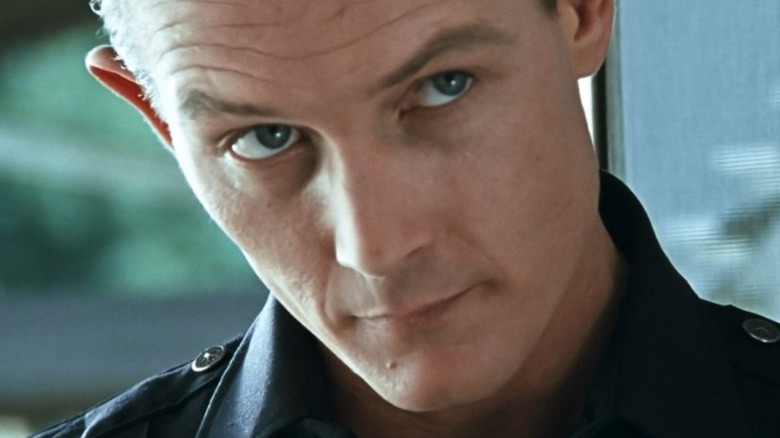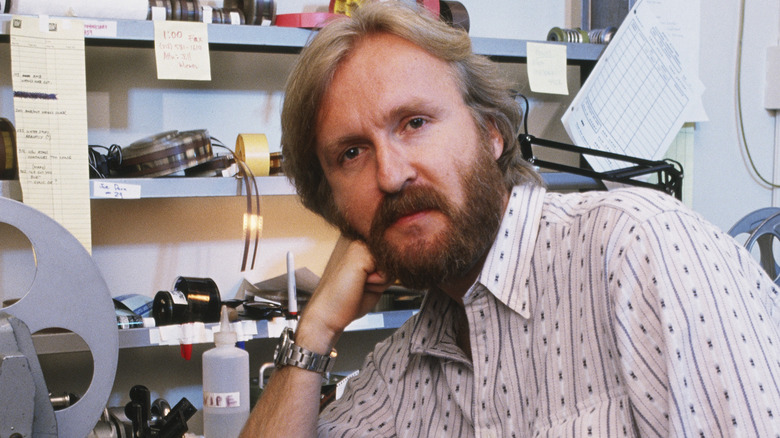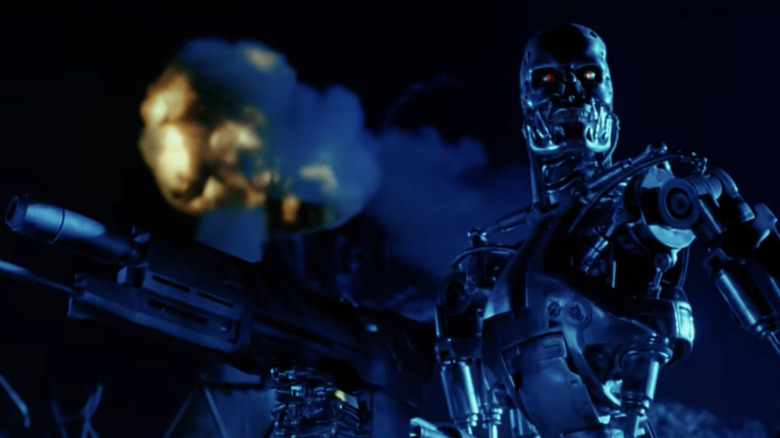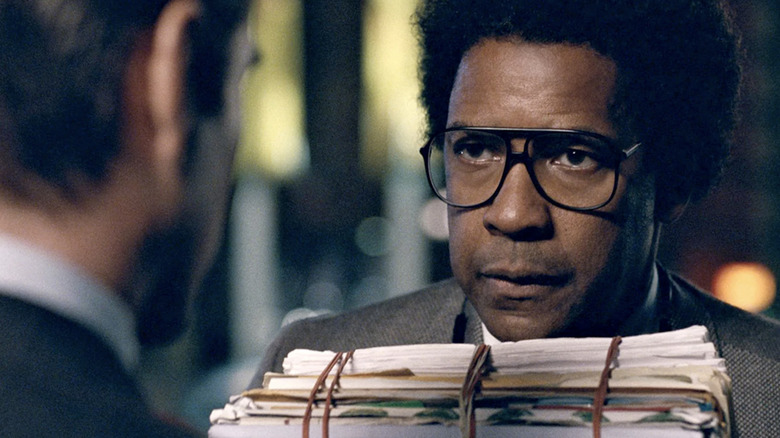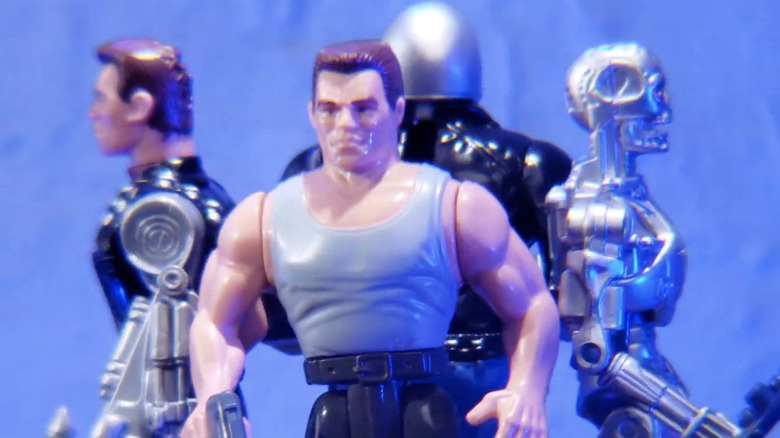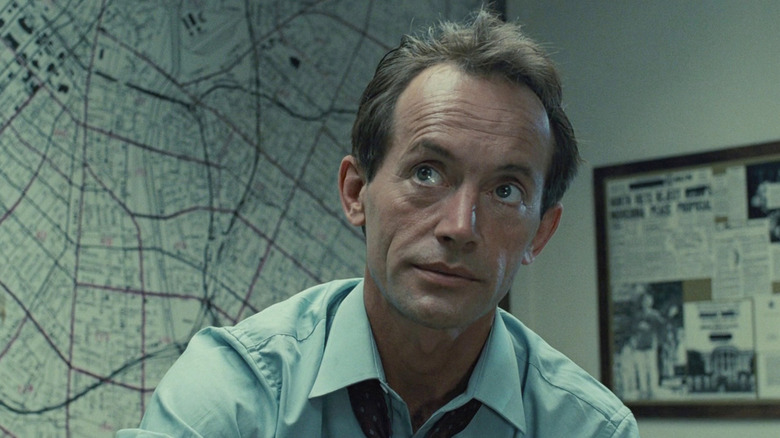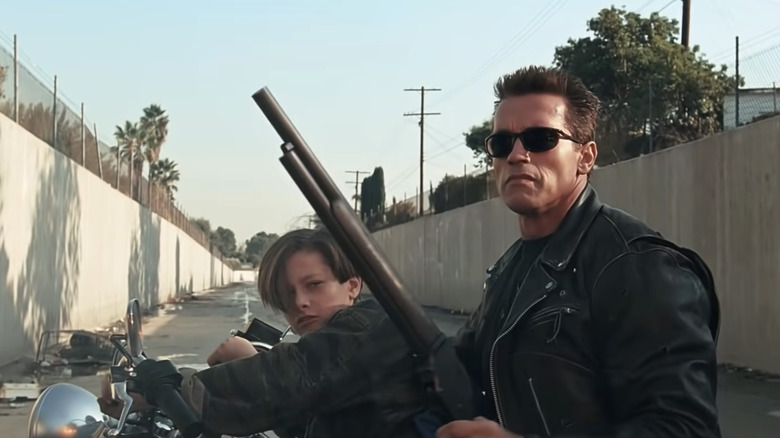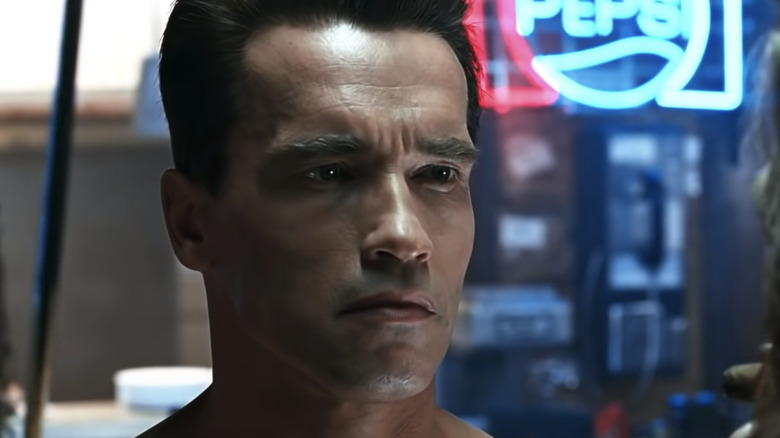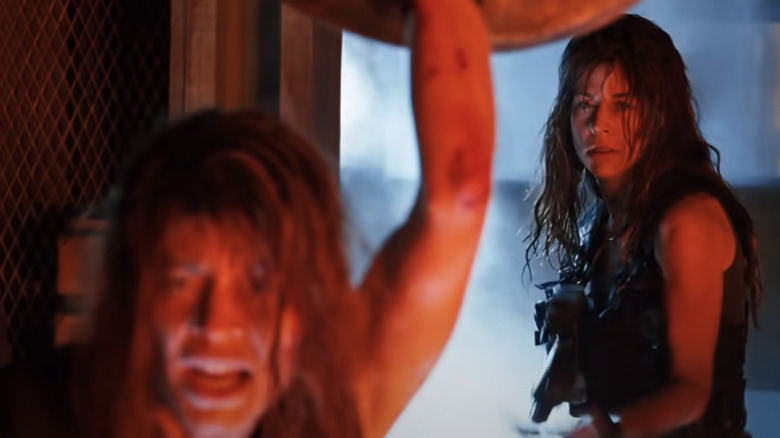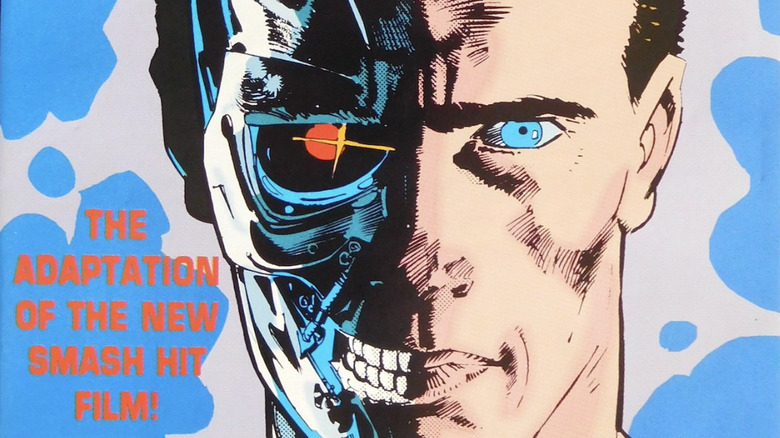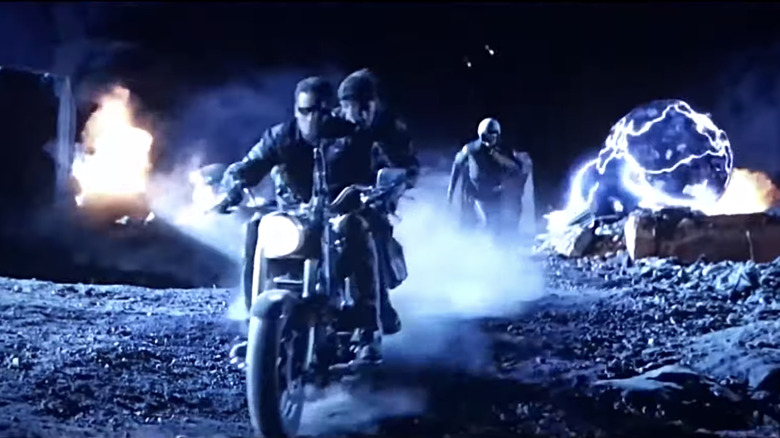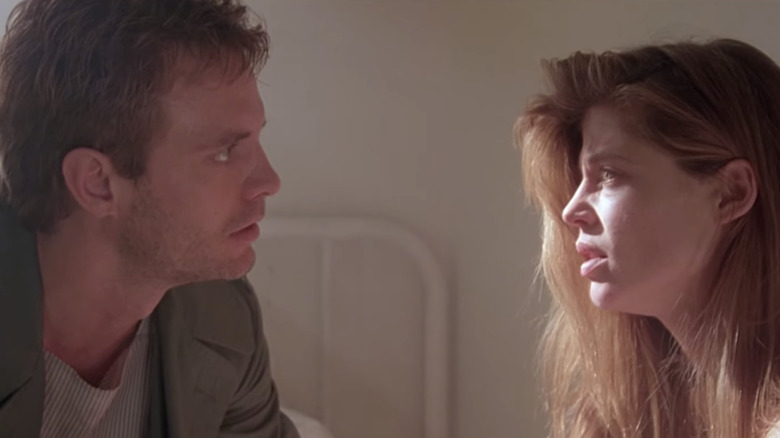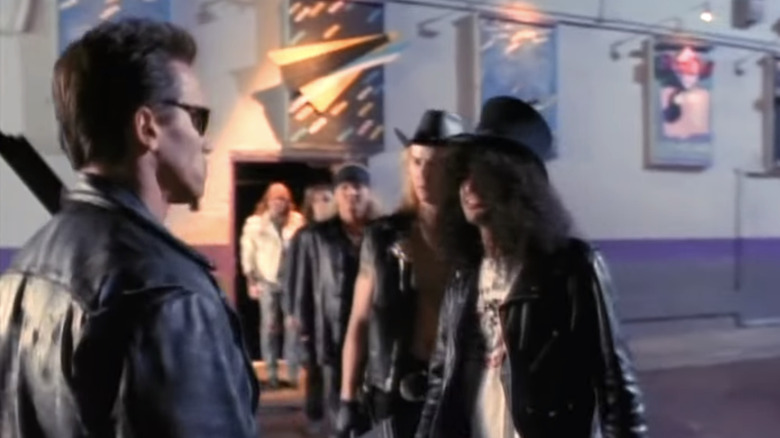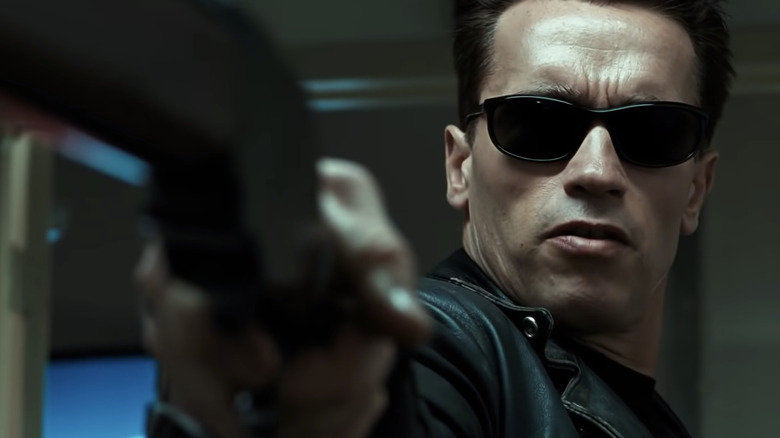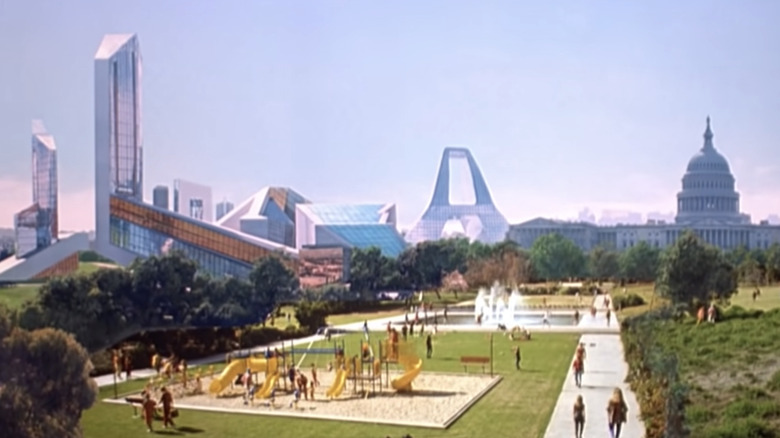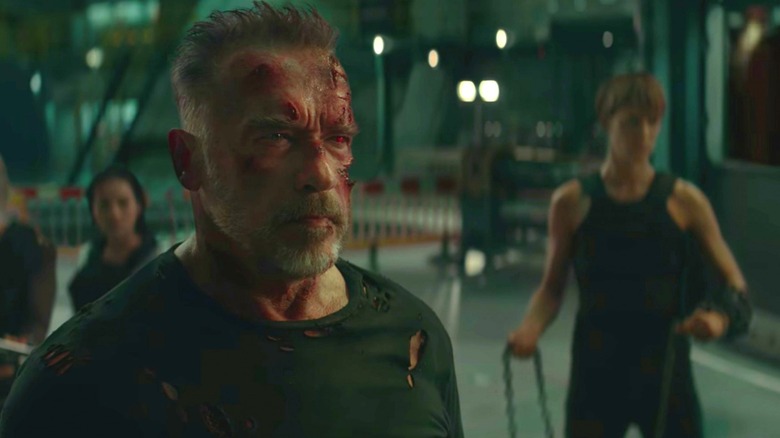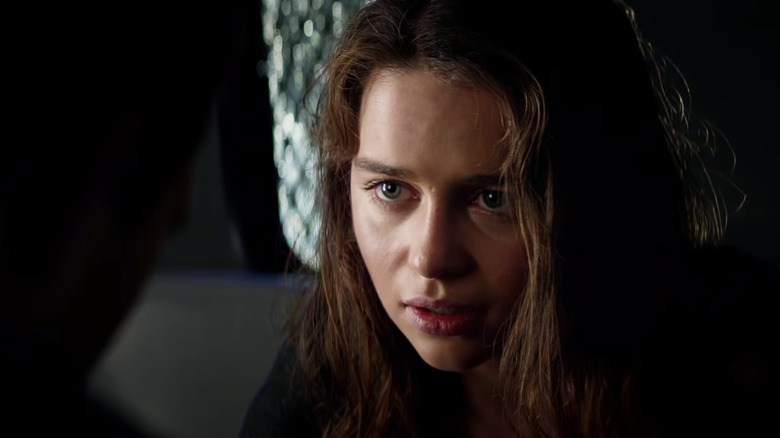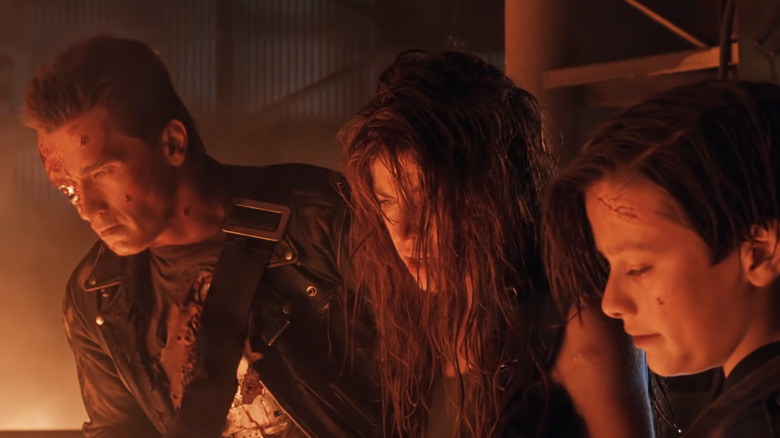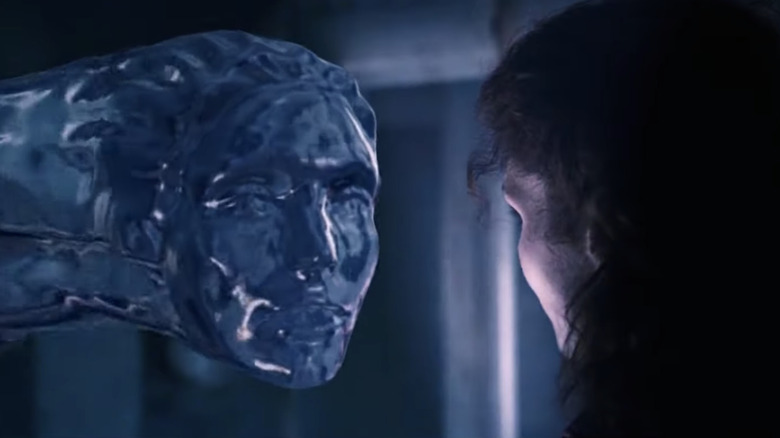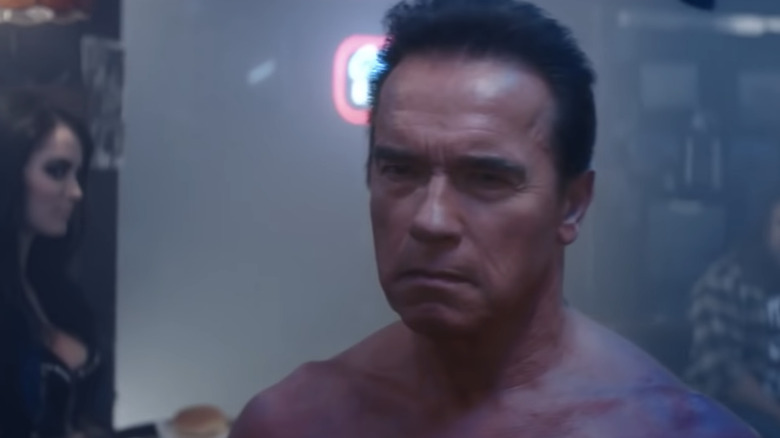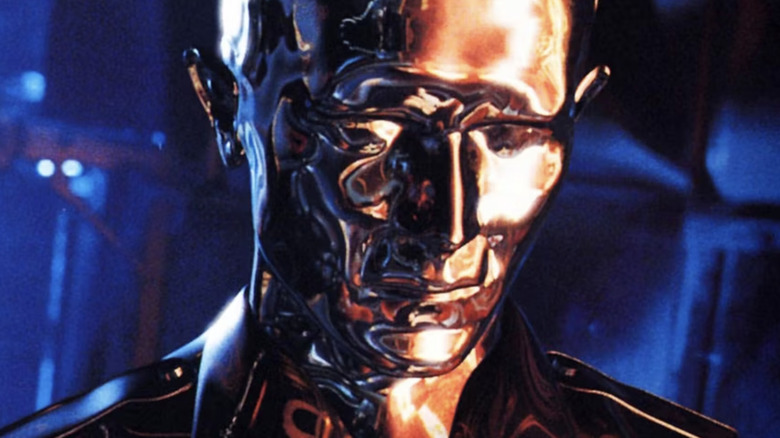The Untold Truth Of Terminator 2: Judgment Day
Often considered the greatest action film of all time, "Terminator 2: Judgment Day" is a masterclass in science-fiction filmmaking and a pulse-pounding journey that flips everything you knew from the first film on its head. Starring a powerhouse ensemble of actors including Arnold Schwarzenegger, Linda Hamilton, Robert Patrick, Joe Morris, and Edward Furlong, "T2" was an instant classic, and one that has yet to be topped by any subsequent "Terminator" installment. While many of the "Terminator" sequels have attempted to cash in on the success of James Cameron's first two entries by rehashing ideas, "Judgment Day" only desired to continue the story and confound our own expectations.
After more than 30 years, "Terminator 2" remains one of Cameron's most influential films. Long before "Avatar" and even "Titanic," Cameron used his experience on "Aliens" and "The Abyss" to help craft a sequel to "The Terminator" that would be worthy of the name, and go down in history as one of the best sci-fi films of all time. While some of the most die-hard "Terminator 2" fans out there might think they know everything there is to know about this epic sequel, we're here to share some interesting tidbits to add to your own personal "T2" database. So put on your clothes and your boots and hop on your motorcycle, because here is the untold truth of "Terminator 2: Judgment Day."
James Cameron originally didn't want to direct it
Looking back, it's crazy to think that anyone else could've directed "Terminator 2" other than James Cameron. Of course the same guy who put together the original "Terminator" on a small $6 million budget would return to direct the sequel, right? While that might be a sure thing by today's standards, it wasn't exactly back then. As early as 1985, rumors of a sequel to "The Terminator" circulated among various horror and science-fiction magazines, with Cameron telling Cinefantastique, "We've got a story worked out, but it hasn't gone beyond the talk stage." The following year, Cameron would direct "Aliens," the Sigourney Weaver-led sequel to the original Ridley Scott film.
Upon the release of "Aliens" in 1986, Starlog magazine published an interview with Cameron in which he stated while "Terminator 2" was probably coming, he planned to let someone else take the helm. "I've already decided not to direct it," he explained, reasoning that at the time, he'd made more sequels than originals in his career, which included his directorial debut, "Piranha II: The Spawning," as well as script duties on "Rambo: First Blood Part II." Although Cameron had no interest in directing a "Terminator" sequel, he did confirm that he and producer Gale Anne Hurd would still oversee the project, stating a few years later that "T2" was "Gale's project" (per Starlog). But as we now know, Cameron would soon after confirm his own involvement on "T2," and would eventually return to both co-write and direct the sequel. It's hard to imagine we could've had anyone else.
The Future War was cut
In "The Terminator," we're treated to a few of Kyle Reese's flashbacks (or are they flash-forwards?) that better establish the dark future from which the Resistance fighter has traveled. We witness the horrific struggle between man and machine that results in countless deaths and constant destruction. Through all of it, Kyle finds solace in a picture of a young Sarah Connor — the mother of his mentor, Resistance leader John Connor — studying it dutifully in preparation for the events of the film. These glimpses into the future remain some of the best parts of "The Terminator," and something fans at the time hoped to see more of going forward.
The way "T2" starts, it seems like that's exactly what we're going to get ... but it lasts for just a few moments before the titles roll. According to James Cameron himself, there was originally a lot more, including a full sequence in which an older John Connor sets the events of the first film into motion from the future (per Starlog). While we didn't end up seeing John fight the Future War in "T2," these ideas would eventually be recycled in the post-apocalyptic sequel "Terminator Salvation," as well as the opening of "Terminator Genisys" (which just so happens to be the best part of the movie). While it's a shame we never got to see more of Cameron's Future War, the mystery surrounding the world of post-Judgment Day America helps make "T2" all the more exciting.
Denzel Washington almost played Miles Dyson
It's hard to imagine anyone else playing the role of Miles Dyson, the brilliant director of special projects at Cyberdyne Systems played perfectly by Joe Morton. Morton has gone on from "T2" to appear in "Of Mice and Men," "Speed," Godzilla: King of the Monsters," and as the father of the superhero Cyborg (a role very similar to Dyson) in "Zack Snyder's Justice League." But before Morton was locked into "T2," director James Cameron originally looked to Denzel Washington for the part. Washington would later comment about this to Premiere Magazine, saying, "No offense to Jim Cameron ... but when I read the script, I thought, 'All he does is look scared and sweat.' I had to pass."
While we'll never know what Washington's version of Dyson would've looked like alongside Arnold Schwarzenegger and Linda Hamilton, we do know that it opened up Washington's schedule to work with Spike Lee on "Malcolm X." Washington has had an incredible career, and has even starred in his fair share of action movies alongside dramatic roles. Though he'd never end up working with James Cameron, Washington's greatest hits — which include "Flight," "Fences," "Training Day," and "The Book of Eli" — have continued his stellar track record. Though it would've been awesome to see him in "Terminator 2," there's no doubt that Washington made the right call, opening the door for Cameron to cast Joe Morton as the self-sacrificing family-man.
The merchandise was marketed to children
There was a trend in the 1980s and into the '90s of merchandise — namely action figure lines — from R-rated action films such as "Rambo," "Alien," "Predator," and "RoboCop" all aimed towards children. In the same vein, animated series, video games, comic books, and even Halloween masks were often produced and marketed to kids to help sell said toys. Like many of these R-rated action films, "Terminator 2" also had a semi-popular Kenner toy line that featured various incarnations of Arnold Schwarzenegger's famed T-800, along with Robert Patrick's T-1000 (which looked nothing like Patrick) and others. One Arnold-based figure even had a giant power-claw attached to its arm.
The longer these toy lines continued, the stranger they got. Eventually, the line was rebranded from simply "Terminator 2" to "Terminator 2: Future War," and began featuring plenty of other strange "Terminator" creations that hadn't been seen in the films. These included Kromium, a devil-looking Terminator complete with horns, and the Cyber-Grip Villain, who seems to be some sort of human/machine hybrid. Out of all the heroes fans would remember from the first two movies, the only human character to get his own action figure is the young John Connor. That's right — they didn't even give the scarred future Resistance leader his own toy. They just settled for the younger teenage version.
Lance Henriksen hoped to return for the sequel
Lance Henriksen has been around for a long time. Possibly most beloved for his role as former FBI profiler Frank Black on the Fox series "Millennium" and as the android Bishop in the "Alien" franchise, Henriksen has shifted from horror ("Pumpkinhead") to animation ("Tarzan") to superhero productions ("DC's Legends of Tomorrow") and beyond over the course of his extensive career. Having worked with James Cameron on just about every one of his early pictures since "Piranha II," Henriksen also appeared in "The Terminator" as Los Angeles Detective Hal Vukovich, who tries to save Sarah Connor from the Terminator.
Although Arnold's original Terminator blasts his way through the police station, nearly killing Sarah and Kyle Reese in the process, Detective Vukovich manages to survive the encounter. While promoting his reunion with Cameron for "Aliens" in 1986, Henriksen expressed his desire to return to the world of "The Terminator," stating, "You never see me die, so I was telling Jim Cameron that it could start in the hospital with me covered with scars saying, 'Look, if this guy came once, he's gonna come again" (per Starlog). Given the track record between Henriksen and Cameron — who, according to IMDb, ended up working on three feature films and a handful of documentaries together — it's easy to speculate as to how "T2" could've incorporated a broken Det. Vukovich into the narrative.
T2 had a massive budget
By today's standards, the budget behind "Terminator 2: Judgment Day" might not seem all that impressive, especially when put up against films like "Pirates of Caribbean: On Stranger Tides" or the last three "Avengers" sequels, which rank as the most expensive films of all time (per Insider). But, as we well know, just because something's expensive, that doesn't mean it's always good — and vice versa. James Cameron made the original "Terminator" on a budget of only $6 million, but the film ended up grossing over $78 million during its 1984 theatrical run. Because of the success of the first film, Cameron was given a budget of over $94 million to make "T2" (via Newsweek), with a $6 million paycheck for himself (per The Ringer).
Although there's been speculation that the movie's final price tag wound up closer to $100 million (via Empire), money wasn't a factor in the plot that James Cameron and co-writer William Wisher put together. Rather, they approached it solely from a storytelling lens, focusing on what they wanted to see rather than the constraints of financing. Cameron once remarked to Entertainment Weekly, "I didn't really think that much in terms of budget but in terms of what the film should be to satisfy the audience's expectations." Thankfully, it paid off – according to Box Office Mojo, "T2" brought in over $500 million, making it the highest-grossing film of 1991.
Christmas was ruined for T2
Filming a movie is stressful, and it can be even more stressful when you have an enormous budget to work with and are trying to trailblaze CGI technology beyond where it's gone before. Thankfully, the holidays are often a time when people can relax, enjoy being with their families, and ignore the stresses of work for at least a few days. While many of the cast and crew had the chance to attend a "T2" Christmas party in December of 1990 while the film was still in production, not everyone was so lucky. During that time, James Cameron and his post-production team were working hard on the film's intense special effects, with Cameron himself editing on Christmas Eve (via Cinephila & Beyond).
In fact, Cameron convinced his lead star to remain available for emergency filming. Although Arnold Schwarzenegger was initially unwilling to submit to Cameron's demands, he eventually reconsidered and began cancelling his plans. This included an appearance at his own Christmas party — a party to which he had already invited plenty of friends and acquaintances — as well as his in-laws' own party. Evidently, Schwarzenegger was also planning on heading to Saudi Arabia with then-President George Bush to encourage the troops overseas during the holidays, but was forced to cancel that trip, too. In the early '90s, it seems that not even Santa Claus could escape the Terminator.
Linda Hamilton's twin sister co-stars
Of all the changes that "Judgment Day" brought to the "Terminator" universe, perhaps none have been more impactful than the development of Sarah Connor. Originally a scared young woman fighting for her life, "T2" turns Sarah into a warrior hell-bent on protecting her son and stopping the Future War from ever happening. Played to perfection by Linda Hamilton, Sarah's relentlessness proves time and again to be one of her greatest strengths, and that includes the final moments of the film. After the T-1000 copies Sarah's DNA, he tries to lure John into a trap, only to be exposed and blown apart by an angry Sarah.
To achieve this double-Sarah effect, Linda Hamilton's twin sister Leslie Hamilton Freas arrived on set, with the pair appearing in one shot of the film together (via The Ringer). This earned Leslie a seat beside her sister at the film's Hollywood premiere, not to mention a spot in "Terminator" history. This would be Leslie's only film role, as she worked for years as an emergency room nurse before transitioning to her role as a hospice nurse until her death in 2020 (via Today).
The film was adapted by Marvel Comics
After "The Terminator," NOW Comics began publishing a series of "Terminator"-themed books that hoped to continue the story, with many of the issues taking place during the Future War of Kyle Reese's timeline. NOW's run on "Terminator" comics ended with the epic "The Burning Earth" story that chronicled John Connor's journey to defeat Skynet – a book that was drawn by comic book superstar Alex Ross in his first published work (per Dark Horse Comics). Then, in 1990, Dark Horse began publishing their own series, beginning with "The Terminator: Tempest." Although Dark Horse would continue publishing "Terminator" books through the '90s, they weren't the only ones who took a crack at it.
In September of 1991, just two months after "T2" was released, Marvel Comics launched a three-issue mini-series – split into issues titled "Arrival," "Escape," and "Departure" — re-telling the events of "Terminator 2: Judgment Day." Written by Gregory Wright with art by Klaus Janson, Marvel's "T2" adaptation was eventually collected into a trade paperback edition that ended up feeling a lot more kid-friendly and colorful than the actual film. Speaking of the artwork, aside from the T-800 — who occasionally resembles Arnold Schwarzenegger — most of the characters look very little like their live-action counterparts, but seeing as how the comic was aimed more at kids than average moviegoers, this hardly comes as a surprise.
James Cameron directed a short sequel
For the lucky "Terminator" fans who had the opportunity to go to Universal Studios in Hollywood or Florida between 1996 and 2017, "T2-3D: Battle Across Time" was a live-action theme park attraction that cost $24 million to make, according to Inside the Magic. A mini-sequel to "T2" in the form of a 3D movie with in-theater effects, "Battle Across Time" is the only film project to reunite Arnold Schwarzenegger, Linda Hamilton, Robert Patrick, and Edward Furlong on big screen, along with James Cameron behind the camera. This 3D experience saw John and Sarah rescued from the T-1000 once again by a brand-new(ish) T-800 before it takes John to the future to defeat Skynet for good. It's quite an explosive experience, and the filmmakers even invented a few new Terminator models for the production.
Aside from a few inconsistent plot holes, the three weeks of night shoots in the Arizona desert really paid off. Not only does "T2-3D" look great, but it expertly combined film with the stage. Like most James Cameron productions, new 3D technologies had to be invented in order for "T2: Battle Across Time" to become a reality, and while many fans of the franchise wanted a third Cameron-directed "Terminator" feature set in the future, this is definitely the closest we're ever going to get. If you're still hoping to see it, you'll have to travel to Universal Studios Japan, which is the only theme park still playing "Battle Across Time."
The Special Edition adds some important context
There are plenty of alternate versions of your favorite films out there that only add a few shaky scenes that don't contribute much to the story. While "Terminator 2" didn't need any additional content — it's a pretty perfect movie as it stands — the "Special Edition" of the film adds a few scenes and extends some moments that simply make "T2" more interesting (per Paste Magazine). Standouts among these extensions include Sarah's emotional vision of Kyle Reese (with Michael Biehn reprising his role from the first film), which helps us ease into her uneasy mental state, and a scene between the Connors after deactivating the T-800 that gives John more agency and Sarah time to express her doubts about the machine.
The "Special Edition" adds about 15 extra minutes to the film, and allows for more time with our characters so that they (and we) can reflect on the circumstances closing in on them. Of course, James Cameron himself was always happy with the theatrical cut (per This or That Edition) — which is why the "Special Edition" should never be called a "Director's Cut" — but there's no doubt that many of these extra scenes serve to enhance the narrative and our characters' motivations, especially Sarah's.
Arnold Schwarzenegger teamed up with Guns N' Roses
You might remember that there's a connection between "Terminator 2: Judgment Day" and Guns N' Roses, but you might not know the whole story. Aside from Arnold's Terminator carrying a shotgun in a literal box of roses in the movie, and John Connor's obsession with playing GNR as a kid in "T2" and an adult in "Terminator Salvation," Schwarzenegger himself actually appeared as the T-800 in the band's music video for the unofficial "Terminator" anthem "You Could Be Mine." That's right — the video features the Terminator stalking the band at one of their concerts, intercut with clips from the film, and ends with the cyborg determining that the band is no potential threat.
Aside from Arnold's appearance in the music video, which was directed by special effects legend Stan Winston, the film was also screened to the band before they signed off on having their music included. Axl Rose and Slash must've been impressed. According to James Cameron (via The Ringer), the band didn't even ask for his permission to include Arnold in their video as the Terminator, they went right to the hulking movie star himself, who was happy to oblige.
The big twist was spoiled in the trailers
The first "Terminator" followed Kyle Reese and Sarah Connor as they fought to evade the hulking Terminator that's been sent back in time to kill Sarah and stop the birth of her son. Kyle sacrifices himself in the final confrontation, and Sarah eventually defeats the T-800 by crushing it in a hydraulic press. In "Terminator 2," Arnold Schwarzenegger returns as a new Terminator searching for John Connor, seemingly to kill him. Along the way, we discover that Robert Patrick's character is doing the same thing, and after John gets caught in the middle of them both, Arnold's Terminator reveals himself to be a hero here to protect the Connors, saving John from the shapeshifting T-1000.
If you're one of the few to experience "Terminator 2" without this twist being spoiled for you, you were truly blessed. Unfortunately for many, the trailers were no help in keeping this one a secret, and the big "T2" twist was spoiled in the marketing — a failure that all future "Terminator" sequels would repeat. But while this mind-blowing twist was revealed in trailers and promotional material in America, some markets were more savvy. According to a video essay by Casey Stelken, the Japanese press junkets were asked not to spoil the big twist and instead cut their trailers around Sarah and John seemingly running from Arnold's Terminator, with very little footage of Robert Patrick's character at all. If only the U.S. would've been as careful.
There's an alternate ending
Besides the Special Edition of "T2," there's yet another version of the film called the "Ultimate Cut." Available on some home video releases, this variation includes only a few extra moments, but what makes this cut especially notable is the inclusion of the film's alternate ending. Here, we see an old Sarah watching over a now-adult John — who happens to be a United States Senator — and his young daughter as they play at a Washington D.C. playground. While the playground isn't especially futuristic, the buildings of 2029 are, revealing that D.C. has gone through quite a change between the mid-1990s and the movie's vision of the 2020s.
This alternate ending feels pretty unnecessary after Sarah's final highway monologue, which allows for a bit of ambiguity to the way "T2" ends. We hope that Judgment Day has been averted, but we're not completely sure. Sequels like "Terminator 3: Rise of the Machines" and "Terminator: Dark Fate" would eventually prove that Skynet (or some other rogue AI) wouldn't be so easily defeated, but "Terminator 2" ends with a sort of Schrodinger's Cat — the future could be set, or it could not be. We get to choose. Thankfully, the "Special Edition" and theatrical cuts of the film keep this uncertainty intact, and while it's cool to see the alternate ending once, it's obvious why it was axed in the first place.
The sequels failed to imitate its success
Part of what makes "Terminator 2: Judgment Day" so exciting is that the film takes everything that made "The Terminator" great and flips it on its head while still building on the original source material. Rather than make another horror movie, James Cameron made an epic action film. Rather than making Arnold Schwarzenegger the terrifying villain again, he chose the less physically intimidating Robert Patrick and made Arnold the hero. And rather than bringing back Sarah Connor as a scared young woman on the run, he made her a fierce warrior. "Judgment Day" flips the script on "The Terminator," in all the best ways.
Unfortunately, the other sequels that followed didn't get the memo. "Terminator 3: Rise of the Machines" may not be that bad, but it's a lot like it's predecessor, just with a less compelling plot behind it. "Terminator Genisys" attempts to re-write the franchise into a Marvel-like action-comedy, but in doing so sacrifices the tone of the series, alienating both newcomers and longtime fans. While "Terminator: Dark Fate" — which saw James Cameron returning as executive producer — gets the tone right, it's essentially a remake of the first two films, making something pretty unoriginal and bland. The only sequel that really attempts to do anything different is "Terminator Salvation." While it has its flaws, it's easily the most interesting of the bunch because it does something new, opting to explore the Future War with no reference to time-travel or any plans to stop Judgment Day.
James Cameron gave his stamp of approval to two of the sequels
For years, fans were frustrated with the likes of "T3" and "Terminator Salvation," with many more upset at James Cameron's lack of involvement in the franchise after "Judgment Day." While the decades that followed "T2" found him focusing on "True Lies," "Titanic," "Avatar," and documentary work, he wouldn't stay away forever. Cameron didn't have an actual role in the production of 2015's "Terminator Genisys," but he did help promote the film during its initial marketing campaign, even referring to it in a promotional featurette as "the third film."
This wasn't the last time James Cameron would promote a sequel to "Terminator 2." Hoping on board "Terminator: Dark Fate" as a producer and co-writer, Cameron was heavily involved in both the creation and making of the 2019 film. In fact, keeping with his tradition of flipping the script on the audience, Cameron was the one who had the idea to kill off John Connor, a decision that was met with tons of fan outrage and frustration (per IGN).
The movie is all about the nuclear family
Aside from the literal threat of nuclear warfare, there's another nuclear element that "T2" touches on quite a bit: the nuclear family. Sure, Arnold's T-800 isn't exactly John's father, but he inadvertently takes on the role throughout the film. As Sarah says while watching the Terminator with her son, "Of all the would-be fathers who came and went over the years, this thing, this machine, was the only one who measured up. In an insane world, it was the sanest choice." 30 years later, James Cameron would further emphasize that point, saying, "The heart of the movie is that relationship" (via The Ringer).
Although the film no doubt challenges traditional gender roles, it often acknowledges that the T-800, Sarah, and John make up their own makeshift "family unit." The T-800 steps into the masculine ideal as a strong and powerful force of nature, especially when protecting his "family." He's even willing to sacrifice himself at the end of the film to save John, something a good father would do. But the Terminator also admits that it cannot cry. By contrast, Sarah has no problem showing her emotions in the moment, though she remains closed off to John for most of the film. That is, until the end, when she learns to become more of a mother to John than just a robotic drill sergeant.
Aliens and The Abyss made the film possible
"Terminator 2" wasn't the first time James Cameron dabbled with a digital liquid humanoid — that honor belongs to his underwater masterpiece "The Abyss." Following a U.S. search and recovery team as they attempt to reach a downed American submarine before the Soviets, this 1989 film was a real trailblazer for CGI effects. During production, Cameron hired George Lucas' Industrial Light & Magic to create an entirely new technology to bring his creature to life. According to The New York Times, ILM spent six months to create just 75 seconds of CG imagery for the creature. These leaps in technology would prove invaluable in bringing the liquid metal T-1000 to life in "Terminator 2" (via Vulture).
While the technology used in making "The Abyss" was vital to the making of "T2," the themes and tone that Cameron explored in his 1986 film "Aliens" would be a precursor to those later explored in "Judgment Day." A sequel to Ridley Scott's sci-fi/horror classic "Alien," Cameron's movie changes up the tone from its predecessor in the same way he would later do from "The Terminator" to "T2" — following a small-scale horror thriller with a complex action blockbuster. Likewise, Cameron would create his own "nuclear family" in "Aliens" with Ripley, Hicks, and Newt at the center, even reuniting with "Terminator" alumni like Michael Biehn, Lance Henriksen, Bill Paxton, and special effects master Stan Winston.
WWE 2K16 recreated an iconic scene
Throughout his career, Arnold Schwarzenegger would revisit a few of his most famous roles, but his most inescapable character will always be the Terminator. Reprising the role for every sequel except for "Terminator Salvation" — which used a CG version of likeness anyhow – Schwarzenegger has also revisited the Terminator in a few different commercials, namely for the release of WWE 2K16, which included the Terminator as a playable character. To promote the game, Schwarzenegger joined up with WWE stars Daniel Bryan, Paige, Finn Balor, and Dean Ambrose to recreate one of the most iconic moments of "Terminator 2."
As the Terminator walks into the infamous biker bar, he sizes up Ambrose and demands his clothes, his boots, and his motorcycle. While Ambrose may be no Robert Winley, and Arnold may be a few decades older, the scene still feels just like that treasured moment from "Judgment Day" which first introduced us to the heroic version of Arnold's Terminator. While Schwarzenegger was no doubt trying to help promote his return to the franchise in "Terminator Genisys," this quick commercial shows that sometimes going back to the beginning is the best move.
T2 took home multiple Oscars
Although action films are generally snubbed during awards shows (particularly the Oscars), "Terminator 2" had the honor of being recognized by the Academy. While "T2" wasn't nominated for Best Picture or Screenplay (though it probably should've been), it was nominated for six different awards and won four of them. That's right — "Terminator 2: Judgment Day" won the 1992 Oscars for Best Sound, Best Sound Effects Editing, Best Visual Effects, and Best Makeup. The Oscars for Best Cinematography and Best Film Editing, which it was also nominated for, both ultimately went to Oliver Stone's "JFK."
While director James Cameron wouldn't win his own Oscar for "Terminator 2" (instead taking home the Saturn Award for Best Director that same year), he would win three Academy Awards in 1998 for his work on "Titanic," including Best Picture and Best Director, and would be nominated for three more in 2010 for his science-fiction epic "Avatar." As it turns out, "Terminator 2: Judgment Day" would be the only film in the "Terminator" franchise to be nominated for Oscars, and the movie would earn even more recognition internationally during its initial run (via IMDb). Very few films today are as groundbreaking as "Terminator 2" was during its time, and even fewer still hold up as well after all these years.
